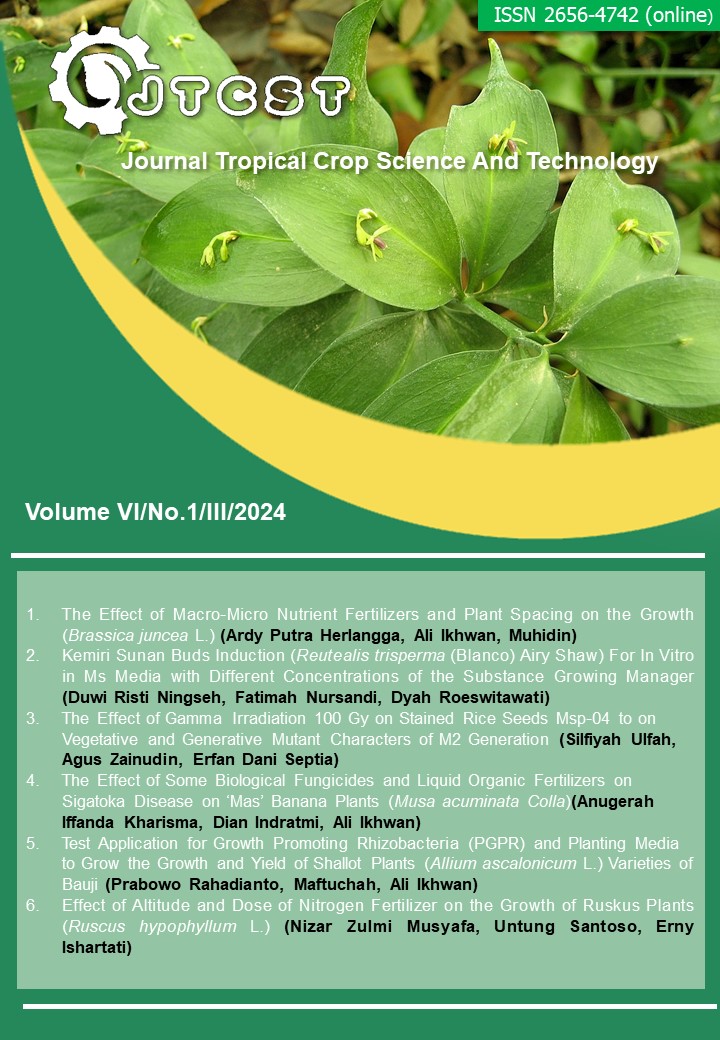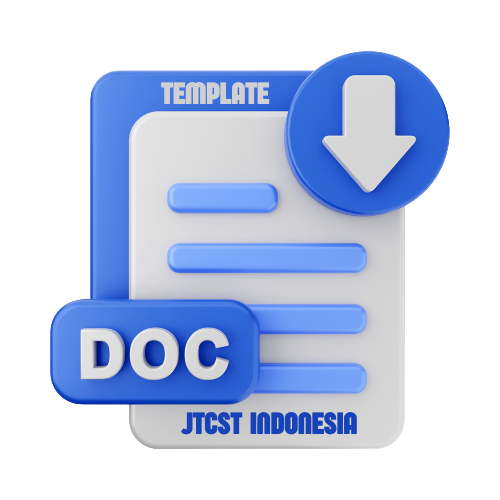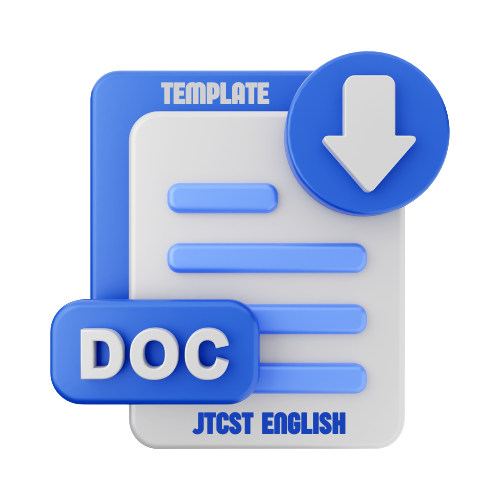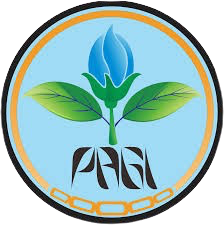Effect of Altitude and Dose of Nitrogen Fertilizer on the Growth of Ruskus Plants (Ruscus hypophyllum L.)
DOI:
https://doi.org/10.22219/jtcst.v6i2.37190Keywords:
Ruscus hypophyllum, altitude, nitrogen fertilizeAbstract
Ruscus hypophyllum is an ornamental plant leaves that serve as cut foliage and herbal medicine. It is growth very slow, only two rods per month, so that is necessary to optimization cultivation, one of them with treatment of altitude (environment) and fertilization This research aimed to determine the effect of nitrogen fertilizer dose altitude for growth of ruskus. The study was compiled using a factorial design nested prepared using RAK and repeated 3 times. The first factor is altitude of 500 m asl (T1), 800 m asl (T2) and 1500 m asl (T3). The second factor is nitrogen fertilization: 0 g/plant (N0), 2 g/plant (N1), 4 g/plant (N2) and 6 g/plant (N3). Based of the research, there was a very real interaction between altitude and dose of nitrogen fertilization on some parameters of observations include: shoot length, number of buds, young leaf chlorophyll, number of roots and root length. The best treatment was a combination of T3N1 (altitude 1500 m asl and nitrogen fertilizer 2 g / plant), separately treatment of altitude very significant effect on the parameters of the number of leaves and shoots appear, and the best treatment is T3 (altitude 1500 m asl). There is a very real correlation between treatment of observations include: the number of long shoots with leaves (0.75), long shoots with the number of shoots (0.64), long shoots with a number of roots (0.79), long shoots with long roots (0, 84), number of leaves with the number of shoots (0.76), young leaf chlorophyll with long roots (0.75) and the number of roots with root length (0.65). The results of path analysis, there are two parameters that have a direct influence on the observation that young leaf chlorophyll (0.094) and the old leaf chlorophyll (0.335).
Downloads
References
Andini, S. dan Purbayanti. 1992. Fisiologi Lingkungan Tanaman. Gadjah Mada University Press. Yogyakarta. 206.
Arisanti, Y. 2010. Analisis Karakter Agonomi dan Pola Pita Isozim Jarak Pagar (Jatropha curcas L) di Daerah Beriklim Basah. Tesis Institut Pertanian Bogor.
Bloem, E., Albihn, A., Elving, J., Hermann, L., Lehmann, L., Sarvi, M. & Ylivainio, K. (2017). Contamination of organic nutrient sources with potentially toxic elements, antibiotics and pathogen microorganisms in relation to P fertilizer potential and treatment options for the production of sustainable fertilizers: a review. Science of the Total Environment, 607, 225-242.
Brown, D. 1995. The Royal Horticultural Society Encyclopedia of Herbs and Their Uses. Dorling Kindersley. London. 424.
Hadzifejzovic, N. 2013. Bioactivity of the extracts and compounds of Ruscus aculeatus L. And Ruscus hypoglossum L. Journal. Institute of Pharmaceutical Biology and Phytochemistry. Germany. 408.
Halada, L. and O. Erdelska. 2005. Reproductive Biology of Ruscus Hypoglossum L. in Slovakia. Journal. Institute of Landscape Ecology SAS. Nitra. 213-214.
Hasanudin, L.O. 2013. Kesuburan Tanah dan Teknik Pemupukan. Buku panduan praktikum. Jurusan Agoteknologi. Fakultas Pertanian. Universitas Haluoleo.
Hasanah, F. 2016. Kajian Penggunaan Berbagai Komposisi Mulsa Organik Lembaran Terhadap Pertumbuhan dan Hasil Tanaman Kubis Bunga. Skripsi. Fakutas Pertanian-Peternakan UMM. Malang. 35.
Pahalvi, H. N., Rafiya, L., Rashid, S., Nisar, B., & Kamili, A. N. (2021). Chemical fertilizers and their impact on soil health. Microbiota and Biofertilizers, Vol 2: Ecofriendly tools for reclamation of degraded soil environs, 1-20.
Paz, M.P. 2003. Rhizome Manipulation Affects Gowth and Development of Ornamental Gingger. Thesis.Faculty of The Louisiana State University and Agicultural and Mechanical College. Honduras. 7-8.
Purwito, A. 2005. Perbanyakan Ruskus (Ruscus hypophylum L.) Secara In Vitro. Journal. Fakultas Pertanian. Institut Pertanian Bogor. Bogor. 39-41.
Salisbury, B. S and Ross C.W. 1995. Fisiologi Tumbuhan. jilid 2 .Diterjemahkan oleh Sitompul S.M. dan M Guriitno. ITB Bandung. 75-77.
Thomas, P. A. and T. A. Mukassabi. 2014. Biological Flora of the British Isles: Ruscus aculeatus.Journal of ecology. UK. 1087.
Downloads
Published
How to Cite
Issue
Section
License
Copyright (c) 2024 Nizar Zulmi Musyafa

This work is licensed under a Creative Commons Attribution-ShareAlike 4.0 International License.
Authors who publish with this journal agree to the following terms:
- Authors retain copyright and grant the journal right of first publication with the work simultaneously licensed under a Creative Commons Attribution License that allows others to share the work with an acknowledgement of the work's authorship and initial publication in this journal.
- Authors are able to enter into separate, additional contractual arrangements for the non-exclusive distribution of the journal's published version of the work (e.g., post it to an institutional repository or publish it in a book), with an acknowledgement of its initial publication in this journal.
- Authors are permitted and encouraged to post their work online (e.g., in institutional repositories or on their website) prior to and during the submission process, as it can lead to productive exchanges, as well as earlier and greater citation of published work (See The Effect of Open Access).











